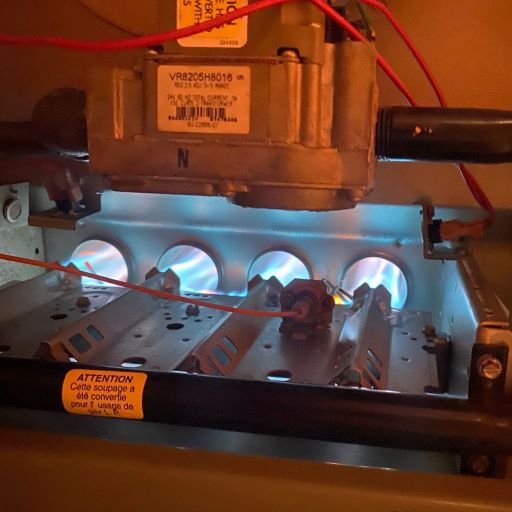Cost to Replace the Ignitor on a Gas Furnace
How much does it cost to replace a furnace ignitor?
$150-300
Average cost is $225.
It's not a complex repair. Some ignitors require special handling to prevent damage which can be an issue for some HVAC technicians.
There are generic ignitors that are compatible with some furnaces. But, using the OEM ignitor is your most reliable option. Some furnace brands are not very well parts supported and the ignitor can sometimes be a challenge to procure.
Quick Links:
Introduction
When the cold months roll in, a fully functioning gas furnace becomes a necessity for a comfortable home. However, like any other household appliance, a gas furnace can experience issues, and one of the most common problems is a faulty ignitor. In this blog post, we will explore the costs associated with replacing the ignitor on a gas furnace, including factors that affect the price.
Understanding the Role of the Ignitor
The ignitor in a gas furnace is a critical component that ignites the gas, providing the heat necessary to warm your home. When it fails, the furnace won't produce heat, leading to an uncomfortable and potentially unsafe situation, especially during winter.
Signs of a Faulty Ignitor
Before diving into costs, it's essential to recognize the signs of a failing ignitor:
The furnace fails to heat the house.
You hear a clicking noise but no flame ignition.
The furnace starts but then quickly shuts off.
Factors Influencing the Cost
Several factors can influence the cost of replacing a gas furnace ignitor:
Type of Ignitor: There are different types of ignitors, like hot surface ignitors or spark ignitors. Each type has a different price range.
Furnace Model: Some furnaces require specific ignitors, which can be more expensive.
Labor Costs: The complexity of the installation and the rates of the HVAC technician affect the overall cost.
Geographical Location: Labor and part costs vary depending on where you live.
Ignitor Failure Rate
Ignitor failure in gas furnaces is a relatively common issue, though the exact failure rate can vary based on several factors. To understand ignitor failure rates, it's important to consider the type of ignitor, the quality of the furnace, maintenance practices, and usage patterns.
Types of Ignitors and Their Reliability
Hot Surface Ignitor (HSI): These are the most common type in modern furnaces. They generally have a lifespan of 3 to 5 years, but this can be shorter depending on furnace usage and maintenance.
Spark Ignitors: These ignitors are more common in older furnaces or specific furnace models. They tend to have a longer lifespan compared to HSIs but are not as commonly used in newer models.
Factors Affecting Ignitor Lifespan
Furnace Quality and Usage: High-quality furnaces that are not overused tend to have ignitors that last longer. Frequent cycling on and off can shorten the ignitor's life.
Maintenance: Regular maintenance can significantly extend the life of an ignitor. This includes cleaning the furnace, checking for proper operation, and ensuring that the furnace isn't running more than necessary.
Environmental Factors: In areas with high humidity or dust, ignitors might fail more frequently due to corrosion or dirt accumulation.
Estimated Failure Rates
While it's challenging to pinpoint an exact failure rate due to the variables involved, it's generally observed that:
A significant percentage of furnace repairs involve ignitor issues, often ranking as one of the top reasons for furnace malfunctions.
Ignitors may fail more frequently in furnaces that are over 10 years old, as wear and tear over time can affect their efficiency and functionality.
In well-maintained and newer furnaces, ignitor failure might be less common, occurring closer to the end of the expected lifespan of the ignitor.
Preventive Measures
To reduce the likelihood of ignitor failure, homeowners should:
Schedule Regular Maintenance: Annual or bi-annual check-ups by a professional can identify potential issues early.
Replace Ignitors Proactively: If an ignitor is nearing the end of its expected lifespan, consider replacing it before it fails, especially before the heating season.
Ensure Proper Furnace Use: Avoid overusing the furnace and ensure proper thermostat settings to reduce the strain on all components, including the ignitor.
Average Cost
The cost of replacing a gas furnace ignitor generally ranges from $150 to $300. This range includes both the parts and labor. However, this can vary based on the factors mentioned above.
DIY Replacement: If you have the necessary skills, you can purchase an ignitor for about $30 to $80 and replace it yourself, saving on labor costs.
Professional Replacement: Hiring a professional ensures the job is done correctly and safely. The cost for professional installation typically ranges from $120 to $250, depending on the technician's rates and the complexity of the job.
Additional Considerations
Warranty: Check if your furnace is still under warranty, as this could cover the cost of the ignitor and possibly the labor.
Regular Maintenance: Regular furnace maintenance can prevent issues with components like the ignitor and extend the life of your furnace.
Conclusion
Replacing the ignitor in a gas furnace is a relatively affordable repair that is crucial for the functionality and safety of your heating system. While some homeowners might opt for a DIY approach, hiring a professional is often the safest and most efficient choice. Remember to consider the type of ignitor, your furnace model, and local labor rates when budgeting for this repair.
Maintaining your gas furnace and addressing issues like a faulty ignitor promptly will ensure your home remains warm and comfortable throughout the colder months.




